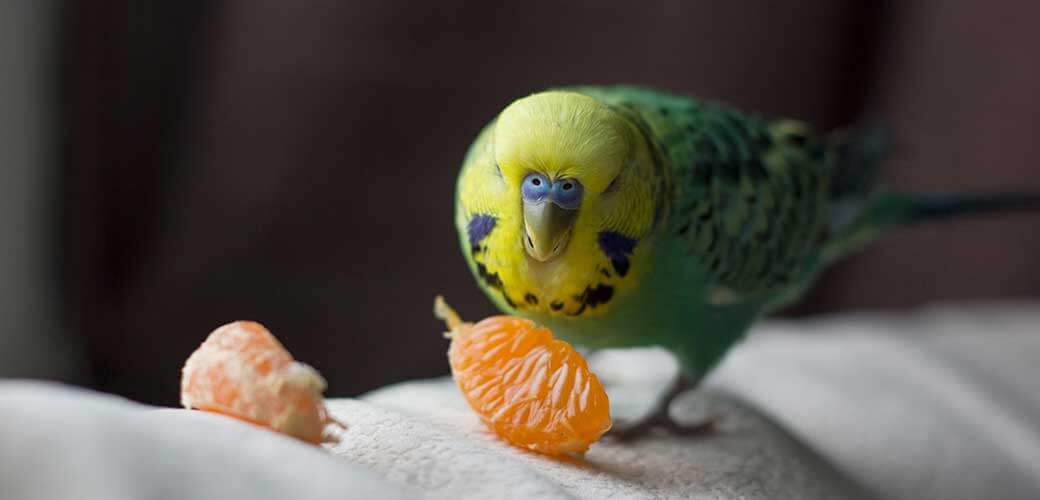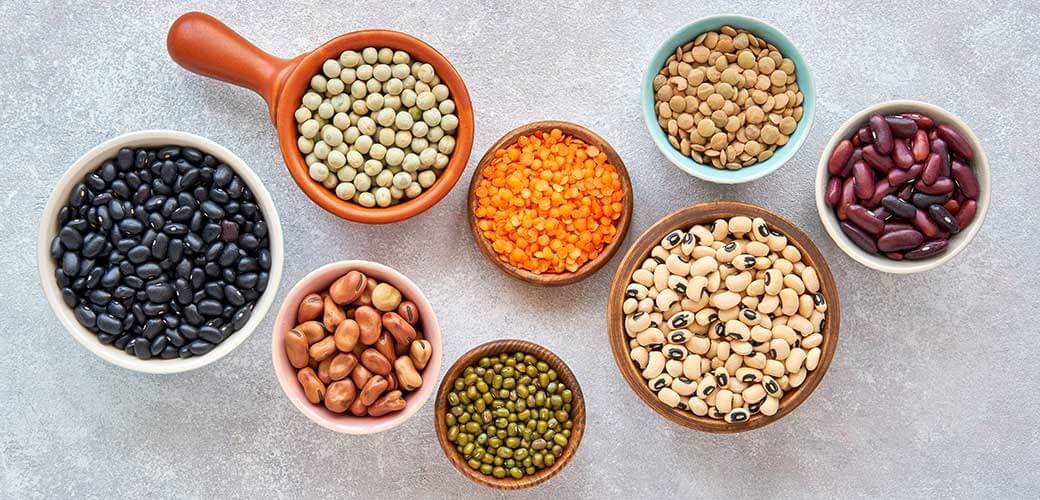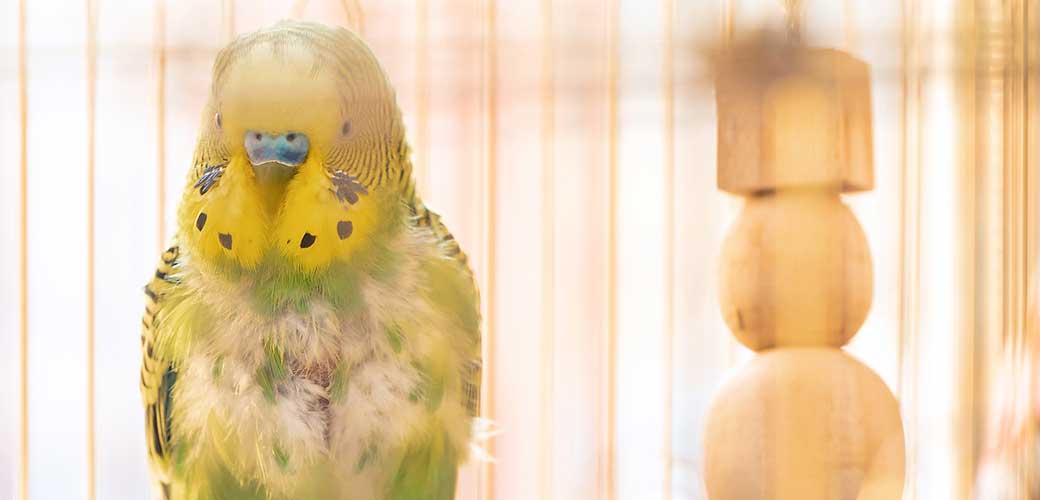Before you bring home a new Parakeet, it’s a good idea to find out more about them and the kind of food that is appropriate for a Parakeet’s diet. Not all pet birds are the same, and some will have more specific dietary requirements than others. Thankfully, there is a range of human food that Parakeets can enjoy, and birdseed and pellets that will work wonders for your new bird’s diet. To find out more about the diet of a Parakeet in captivity and their natural diet, continue reading our guide below.
What Do Parakeets Eat in Captivity?

Parakeets are a type of small bird also known as a Budgie. In captivity, Parakeets eat a varied and wholesome diet provided by their owners. Captivity doesn’t always refer to birds who live in zoos or wildlife sanctuaries it also refers to any Parakeet living in a domestic setting. If you own a Parakeet or are thinking of buying one to keep as a pet bird, they will be in captivity.
Do Parakeets Eat Seeds?

Yes, Parakeets can eat seeds, but they shouldn’t eat too many of them because they aren’t nutritionally beneficial and will fill up their stomach in place of better foods.
Avoid buying bags that contain only sunflower seeds because these are higher in fat than other types of seeds that are better for your Parakeet to eat. Try to find safflower seeds or a seed mix appropriate for birds.
Pet Parakeets eat a mixture of seeds and pellets suitable for birds, fruits, vegetables, legumes, and nuts. Each of these types of food plays a vital part in the diet of a wild or pet Parakeet, so it’s important to feed them the right food and the right amount of it.
Parakeets can eat around 1.5 to 2 teaspoons of seeds and pellets each day, but they won’t need any more seeds than that and shouldn’t be offered too many because they might fill upon them. This is bad because seeds aren’t nutritionally complete, and can’t replace the nutrition that your Parakeet gets from the other foods in its diet.
As well as seeds, add bird pellets to the mix. Pellets are usually nutritionally complete (or close to it) because most bird owners use them for the bulk of their pet bird’s diet. You shouldn’t just feed your bird pellets, though, because they need fresh fruits and vegetables as well. Pellets and seeds should be combined to make up a maximum of two teaspoons.
Can Parakeets Eat Fruit?

Various fruits should be part of this bird’s diet every couple of days. We’ll give a more in-depth list further down, but most households carry apples and bananas – both of which are perfect for Parakeets to much on! Give them just a slice of either, they really don’t need a lot.
Should You Give Your Parakeets Fresh Vegetables?

Most certainly! Fresh vegetables make up a huge part of your bird’s diet after seeds and pellets. Leafy greens are great, and so are sprouted seeds and dandelion leaves. There are plenty of easy-to-find vegetables that birds eat as well, which you’ll find in the next section.
The Pet Parakeet’s Diet
To create a balanced Parakeet diet, you will need to feed your bird a range of foods.
Seeds and Pellets

Of the 1.5 to 2 teaspoons of seeds that are appropriate for a Parakeet to have, any of these are acceptable:
- Canary seeds
- Millet seeds
- Safflower seeds
- Sunflower seeds
Remember that sunflower seeds are very fatty and shouldn’t make up the bulk of the seed part of your bird’s daily diet. Your Parakeet should also not only be eating seeds.
If you’re out of seeds and pellets, you can give your Parakeet nuts to keep them satiated until you get back from the pet store.
Fruits and Vegetables

While seeds and pellets make up 70% of the diet of pet birds, fruits and vegetables make up the next 20%. Of that 20%, you should give your bird more fresh vegetables and less fruit. This is because fruit is naturally higher in sugar and birds really don’t need that much sugar running through their system.
The following fruits are great choices, and are even better if you can find organic versions of them for your bird:
- Apples
- Bananas
- Blackberries
- Coconut
- Peaches
- Pineapple
- Mango
- Melons (including watermelon)
- Seedless grapes
- Tangerines
Remember to remove any fruit seeds or pits before feeding them to your Budgie. Budgies eat fruit, but the seeds and pits can be very dangerous and even toxic in some cases. Better to be safe, than sorry!
As for those fresh vegetables we talked about, leave any of these in your Parakeet’s food dish:
- Asparagus
- Beets
- Broccoli
- Butternut Squash
- Carrots
- Celery
- Cucumber
- Peas
- Spinach
- Sweet potato
- Zucchini
Legumes

Legumes are the final 10% of a pet bird’s diet. A legume can be lentils, soybeans, peas, beans, or even peanuts.
The best legumes to give your Parakeet are cooked lentils, chickpeas, pinto beans, or split peas. These need to be cooked, not raw. Do not feed your bird raw lentils.
Treats You Can Give Your Parakeet
Though treats don’t make up any part of a Budgie’s main diet, Parakeet can eat occasional treats without any repercussions – you just have to make sure you’re giving them the right stuff.
Birds love honey sticks and millet spray. Both are very common in pet stores and are excellent examples of good treats for Parakeets.
You could also try introducing small quantities of cooked pasta (wholemeal, not white) that has been boiled in plain water and left to cool. They won’t get any essential vitamins from pasta, but it’s something fun for them to try.
Parakeets may also enjoy a little dried fruit. You’ll need to be careful with this food, though, because dried fruit has a more concentrated amount of sugar in it than fresh fruit.
A Little About Your Parakeet

These small, colorful birds have long tails and are also known as Budgies. There is often some confusion in the Budgies versus Parakeets conversation because a Budgie is one of the many Parakeet species in the world, but in the United States, all Budgies are called Parakeets.
The name “Parakeet” actually means “long tail”, and though they are a common pet in America, the variant kept is just one of over 120 different wild Budgies out there. These are flock birds, making them very social and perfect for households that are looking for multiple pet birds. Parakeets bond and mate for life, and owning two is the norm.
Parakeet Origin and Habitat
Having originated in Australia, these long-tailed parrots have been exported around the world and can be found in habitats across America. With their varied diet, it’s easy for the Parakeet to find a home.
The Parakeet’s habitat will be in an area with low rainfall. They have a preference for woodland, open grassland, and dry scrub areas. They will build their nests in trees and small hiding places but will forage in open areas for grass seeds, uneaten fruit, and occasional treats. Wild Parakeets love small quantities of different fruits, including berries, but they will also consume nectar from flowers. There are some other differences in the diet of a domesticated and wild Parakeet that stand out:
What Do Parakeets Eat in the Wild?
In the wild, many Parakeets stay healthy by consuming insects, larvae, nectar, and bark. They’ll also forage for fruits and tree seeds around their home. This bird likes a variety of different foods, and like other birds, they aren’t very fussy.
For wild birds to stay in the optimal health range, it’s crucial that they get their nutrition from the food available around them. This includes food that is rich in vitamin C and other vitamins and minerals.
Food to Avoid Feeding Your Parakeet
Do not feed your Parakeet any fried food, caffeinated foods or beverages, or any food that has artificial coloring. They can’t have salty foods or dairy products, such as milk or cheese, and definitely shouldn’t be given any chocolate. Adding this kind of food to a Parakeet’s diet can cause health problems and be fatal. Even in very small quantities, these human foods are dangerous.
There are also various fruits and vegetables that you’ll need to avoid. It might be tempting to try various grocery store varieties of healthy fruit and veg, but even the leafy romaine lettuce is bad for Budgies to eat.
Fruits and vegetables to avoid feeding your Parakeet:
- Avocados
- Citrus fruits, such as oranges
- Garlic
- Onions
- Seeds from apples and pears (which contain trace amounts of cyanide)
- Stones from cherries, apricots, and peaches (again, trace amounts of cyanide)
- The plant part of eggplants, tomatoes, peppers, and potatoes (the body of the vegetables are fine, but ditch the rest of the plant and vine)
- Uncooked, raw, or dried beans (cooked are fine)
Also avoid peanuts, because the high possibility of them being contaminated with mold means that your bird could eat a toxin that will kill them. It’s just not worth the risk.
Symptoms to Watch Out For
If you think your Budgie may have eaten something they shouldn’t have, these symptoms are a sign to take them to a vet trained in bird care:
- Involuntary flapping while resting/asleep
- Feather plucking
- Lack of appetite
- Lethargy
- Rash
- Scratching
- Shaking
- Toe-tapping while asleep
- Wheezing
Parakeet Health Problems to Look Out For

Parakeet parents may appreciate knowing a few of the common health problems that their pet bird may run into. We won’t go too in-depth here, but the more you know about your bird, the better.
-
Budgies Avian Gastric Yeast (AGY) Infection
A highly contagious infection where your Budgie will lose weight no matter what or how much they eat. The infection stops them from being able to digest their food properly, so they end up vomiting it up or it comes out undigested in other ways. The cause of the disease is a type of yeast that leads to a condition called “wasting disease”.
-
Budgie Candidiasis
Another yeast infection that shows in the form of the thrush virus, and can affect the bird’s digestive system. It’s similar to AGY, but symptoms include loss of balance and shaking.
-
Budgie Sneezing
It may sound strange to have sneezing on a list of medical problems, but sneezing or coughing is a symptom of a virus in your Budgie’s upper respiratory tract. The illness is accompanied by listlessness, panting, and a preference for the bottom of the cage rather than flying up or sitting on perches. You may find your bird stretching their neck in an attempt to get more air.
-
Parrot Fever (Psittacosis)
The one illness that every Parrot owner has heard of, Parrot Fever is a bird-borne disease that can be transmitted to humans. Isolation is vital once a diagnosis is suspected as this illness can spread fast among birds housed together. Symptoms include listlessness, ruffled features, breathing issues, and loose droppings.
When to Take Your Parakeet to a Vet
- If your Parakeet shows any signs of food allergies, which are listed in the section “symptoms to watch out for”
- If your bird is pulling out or losing their feathers at a rapid pace
- If your bird isn’t breathing properly or is making wheezing sounds
- If you believe your bird has ingested pear/apple seeds
- If your Budgie’s feathers and fluffed up
- If their droppings are watery
- If your bird is sleeping more than usual or seems to have no energy
- If your bird shows symptoms of any of the illnesses listed above
How to Keep Your Parakeet From Getting Sick
To help your Parakeet avoid all of the nasty illnesses and conditions that can be passed from bird to bird, one of the best things you can do is keep a strict cleaning schedule at home. It’s not just their cage or aviary that needs to be sanitary, it’s an area where your bird may go. Birds can have dust and mold allergies, so it’s important that their environment is as clean as their nest is.
Ensure that you commit to regular cleaning of their housing and its surroundings:
- Dispose of any organic matter, such as uneaten food, droppings, and nesting materials that have been soiled (leave some of their nest so they can recognize it).
- Disinfect their cage with a quality disinfectant made for cleaning bird cages or aviaries (though you can also use one part bleach to nine parts water for an effective cleaning solution that won’t put a hole in your pocket).
- Thoroughly dry out their cage and put in fresh nesting materials and food. Always throw away any uneaten fruits and vegetables the day after they were presented to your bird, and provide fresh water in a clean dish every morning.
Not all illnesses can be avoided by cleaning up after your Parakeet, but the unnecessary ones from an unsanitary environment certainly won’t be pecking on your bird’s door any time soon.
FAQs:
Q: How do I tell if my Parakeet ate something bad?
A: If your Parakeet ate something they shouldn’t have eaten, the main symptoms that will tell you are lack of appetite and lethargy/lack of energy. If your bird appears listless and isn’t eating, or they look ruffled and sick, it’s best to seek veterinary advice as soon as possible.
Q: Where do I find high-quality bird pellets?
A: Finding high-quality pellets for your bird isn’t actually too difficult! You should be able to find something of decent quality in your local pet store, but doing research on brands while you’re standing there can be a bit stressful. Look for pellets that are USDA certified, fortified with vitamins, minerals, and amino acids, and are as natural as possible. There should be no chemical preservatives in the food, and ingredients like real fruits and vegetables are a plus.
Q: How much water does my Parakeet need?
A: Parakeets drink less water than other pet birds during the day. Your feathered friend will likely drink around 5% of their body weight in water each day. The average Parakeet weighs around an ounce, so a bird of that weight would drink approximately 3 teaspoons of water. Your Parakeet needs fresh water every day.
Q: Do Parakeets eat insects?
A: Parakeets in the wild are known for eating insects, but domesticated Parakeets don’t usually have that luxury. Most Parakeet owners will just feed their birds seeds, pellets, and fresh foods instead of bothering with procuring any insects or larvae for their pet to eat. If you did want to try adding more protein-rich foods like insects into your Parakeet’s diet, they like ants, worms (mealworms will work), and will even eat greenflies from your garden.

